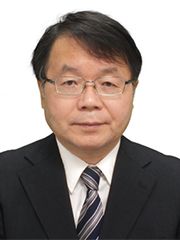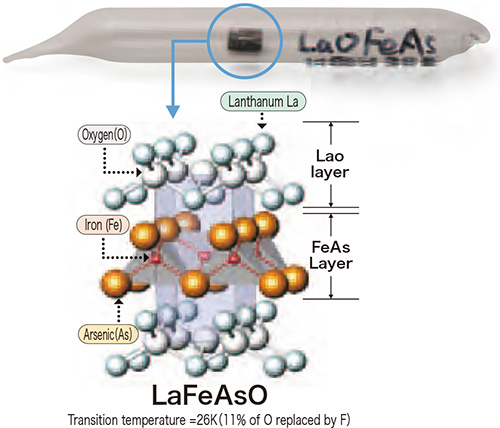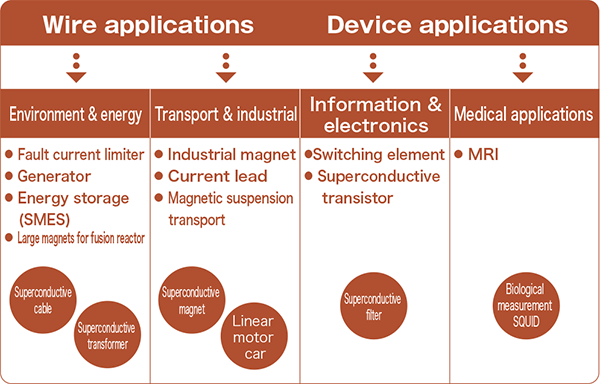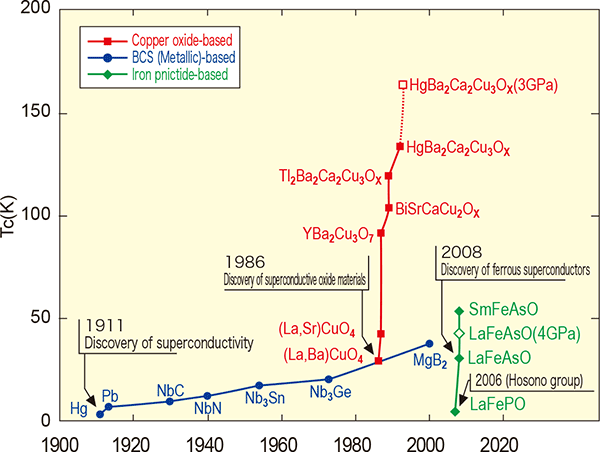Research Results
Uncovering new functions hidden in as-yet unexplored materials
Spurring a New Boom in Iron-Based Superconductors! FY2016

- Hideo Hosono (Professor, Materials and Structures Laboratory / Director, Materials Research Center for Element Strategy, Tokyo Institute of Technology)
- ERATO
- "HOSONO Transparent ElectroActive Materials" Research Director (1999-2004)
- SORST
- "Exploring and Developing Applications for Active Functions Utilizing Nanostructure Embedded in Transparent Oxides" Research Representative (2004-2010)
- ACCEL
- "Materials Science and Application of Electrides" Research Director (2013-2018)
A telling impact: "Thomson Reuters Citation Laureates"
Superconductivity research has always been performed using metallic materials or copper-oxide materials, but in 2008, a research paper on iron-based high- temperature superconductors published by Professor Hideo Hosono had a massive impact on the world of superconductivity. Magnetism and super-conductivity are compete, therefore, no one imagine that a substance that contains iron, which is also the symbolic element of magnetic material becomes superconducting, involved in superconductivity.
The impact of this discovery of the century can be easily judged by the fact that it was dubbed one of "Breakthrough of the Year 2008" by Science magazine. Additionally on September 2013, Professor Hosono was received that announced and selected the researcher of Nobel Prize class as known as "Thomson Reuters citation Laureates." Accordingly, publication of this paper triggered huge research figures— nothing less than a worldwide iron-based superconductor boom— and demonstrated some exciting new possibilities for superconductors.

A serendipitous discovery overturns conventional wisdom in condensed matter physics
This amazing discovery of iron-based superconductors was actually a completely serendipitous discovery made during the course of a search for a new magnetic semiconductor at SORST. Professor Hosono, who made this discovery, had originally been conducting research on transparent semiconductors. During the research on p-type semiconductive property of lanthanum oxide copper selenide (LaCuSeO), Professor Hosono found that it possessed an extremely interesting crys-talline structure and electronic structure. Taking his p-type semicon-ductor research in a new direction, Professor Hosono started investigat-ing magnetic semiconductors possessing spin using this structure. In the course of this research, while examining the properties of lanthanum oxide iron phosphide (LaOFeP),which possess the same structure as LaCuSeO, he serendipitously discovered the occurrence of a superconductivity phenomenon at temperatures around 4K (-269°C).
Since it was previously understood within the field of condensed matter physics that the superconductivity phenomenon does not occur in substances containing some magnetic element, conventional understanding within the field has been overturned by this discovery.
World market for the superconductor industry will be 2-3 trillion yen in 2020!
Upon hearing the word "superconductor," many people may feel that these are something very far removed from us. But actually, superconductors are expected to have many applications in areas close to our daily lives; for example, in the elds of environment and energy, medicine, electronics, transport and industry, and more, with the world market for superconductors expected to reach around 2-3 trillion yen in 2020.
Thus, ongoing superconductor research holds the promise of chang-ing our daily lives in major ways. It is no exaggeration to say that su-perconductor technology will enable us to achieve the future we have dreamed of.
Superconductor applications

Toward a practical application of iron-based superconducting research
Discovered by Dr. Heike Kamerlingh Onnes in 1911, supercon-ductivity was long believed to be achievable only at ultra-low temperatures. However, in 1986, copper oxide materials broke the transition temperature barrier of 100K ( - 173°C), and there was much excitement that a superconductive body capable of functioning at room temperature might exist. However, the subsequent 20 years passed without any great change, and it seemed that the possibilities of metallic-based and copper oxide‒ based superconductive materials had reached a plateau. The announcement in 2008 that Professor Hosono had discovered iron-based superconductive materials, since then many researchers explore new super conductor mate-rials.
Although Iron-based superconductor transition temperature announced that 50K has not been updated since 2008, a basic research of a application of wire rod showing the rapid progress. A wire rod is made by Iron- based super-conductor powder into a tube is easy method and critical current density became increase more than one-digit the last year of half, also it became more close in a value to a currently in a practical use Iron-based wire rod.
At present, among Japan (National Institute for Materials Science) , The United States (University of Florida) and China(Chinese Academy of Science) are competing the best record. Thus, Professor Hosono pioneer an Iron-based superconductor research launch into a new development round.

